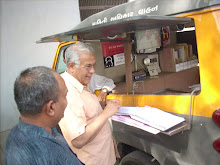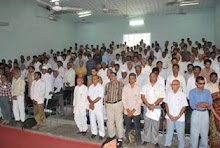The Hans India: Hyderabad: Sunday,
July 17, 2016.
As part of
the road work that was started with the blessings and grants of the AP Government,
big pits were dug at many places and salt water will stand there, rendering the
ground saline. The intervention will hit the natural high tide and ebb
phenomenon and the wave action typical to estuary areas, explain experts. “The
road may not be of any use once the Krishna Pushkarams are over but the damage
will be deep and far-reaching,” laments KLN Murthy.
The two
Telugu states are emerging as veritable theatres of environmental destruction
as forests are denuded, mountains are nibbled away, rivers are killed and air
is polluted Amaravathi Pain Clinic! Thus, proclaims a prominent signboard
outside a shop in the Governorpet area of Vijayawada.
“It is a sign
that reminds me of the way we rush through our work, permissions and orders as
part of that great capital building exercise. It’s truly Amaravathi pain,” a
senior official of the Andhra Pradesh Government, who drives by that road every
day to work, jokes.
Jokes apart,
though, the new development in the two Telugu states, is now being recognised
as among the shoddiest, most destructive, short-sighted exercises of all times,
both on planning and implementation levels. While experts bemoan violations at
many levels, the environment continues to be the first and the biggest
casualty, the damage caused to ecosystems lethal and irrevocable.
The latest in
a string of violations is a road being laid through the Krishna Wildlife
Sanctuary in Krishna district of Andhra Pradesh, for the convenience of the
pilgrims to the Krishna Pushkarams. Environmental activists were quick to react
and file petitions in the court to stay the work.
Imran
Siddiqui of HyTiCoS (Hyderabad Tiger Conservation Society) who first got the
work on the road stayed, has now filed an additional petition in Hyderabad High
Court seeking restoration of the habitat, asking for an order to this effect to
be issued to the government.
Krishna
Wildlife Sanctuary is one of the last-surviving Ecotone regions, an area
between marine and terrestrial habitat, and hence an important ecological zone.
It is the river mouth and home for vast tracts of mangrove forests and many
rare species of animals.
“Forests are
not just those which have big trees with big canopies. In the Krishna Sanctuary
road case, the district collector filed a counter saying there is no forest
where the road is being laid. But the definition of forest is broad and has much
deeper significance. There are deemed forests and by ecological standards, even
a desert is a forest,” points out Imran Siddiqui.
“Often we
consider the mangroves and wetlands as wastelands. That is not right. They are
quite important for eco-balance. The KWS road project is a violation on many
counts. The Wildlife Act, the Supreme Court guidelines and even Coastal
Regulation Zone Rules. That is why we are asking for an immediate damage
assessment,” says Murthy Kantimahanti, Conservation Biologist with Eastern
Ghats Wildlife Society, a not-for-profit organisation fighting on eco-issues.
As part of
the road work that was started with the blessings and grants of the AP
Government, big pits were dug at many places and salt water will stand there,
rendering the ground saline. The intervention will hit the natural high tide
and ebb phenomenon and the wave action typical to estuary areas, explain
experts.
“The road may
not be of any use once the Krishna Pushkarams are over but the damage will be
deep and far-reaching,” laments KLN Murthy.
The biggest victim of the latest venture of the Government may be the
Fishing Cat, a rare species that is an indicator of an Ecotone, and the animal
now faces the threat of extinction.
Roads, the
arteries of development, have now come to symbolise mindless environmental
destruction in India. “There is a super highway near Paderu-Lambasingi area in
Visakhapatnam district. A vehicle goes by that road may be once in five
minutes. Why do we need such roads where massive destruction of forests is
involved?” asks Imran, who has been personally instrumental in saving vast
areas of forests in both the States.
So it was
with the Pulicat Lake where Coastal Zone Regulations were grossly violated in
spite of staunch opposition from activists and experts. The recent Naval Fleet
Review was another case in point where an event caused long-term damage. The
silver linings are few and far between.
The National
Green Tribunal recently directed Ministry of Environment and Forest to take
penal action against TSGENCO for illegally undertaking the Bhadradri Thermal
Power Plant works without prior Environmental Clearance but there are many more
violations that go unchallenged.
The two
Telugu states are emerging as veritable theatres of environmental destruction
as forests are denuded, mountains are nibbled away, rivers are killed and the
air is polluted. “Not just roads, now it is pipelines too.
For Mission
Bhagiratha, long pipelines are laid through forests and it is estimated that more
than 1,200 hectares of forest land is being destroyed for the pipelines.
Warangal, Adilabad, Nizamabad, Medak…every district in Telangana is losing
forests.
We have lost
track of how much forest we are losing but one RTI query told us that a
whopping 3,000 trees are cut every day to be brought into Hyderabad, for use by
hotels as firewood. Just Hyderabad,” Imran expresses his anguish.
Tragically,
the State is turning out to be a bigger perpetrator in terms of destruction.
Permissions are granted rapidly, contracts awarded with lightning speed and
funds released without any ado. There is no environmental impact assessment or
dialogue with experts as projects trundle on hastily laid tracks and
contractors go on the rampage. Rivers are ruled by the sand mafia.
Hills are
playgrounds for quarry owners. Forest lands are granted to pharma giants. And
agricultural land converted into real estate. “Forests, hills, rivers… There is
now extensive quarrying near the Simhachalam range and the hills will soon
disappear,” Murthy says.
“A senior
minister in the Telangana Government recently called out in a speech to plant
saplings in the city under Harita Haaram to resolve drought. Is that a joke or
what? That’s why the Hon’ble Chief Justice reacted so sharply, asking if
planting tiny saplings is a substitute for chopping down 30-40 yr old trees.
And
permissions without discretion? It seems the Forest Department has become a
facilitator for felling trees rather than providing protection.” And now the
mother of all green murders is just round the corner with the AP Government
seeking to de-notify a whopping 19,256 hectares (about 47,000 acres) of forest
land. The State Government not only seeks clearance from the Union Ministry of
Environment and Forests to divert the forest land but also begs for a waiver on
equivalent compensatory afforestation.
“It smacks of
nothing but greed. A Govt of India official walked out of a meeting in disgust
at the State Government’s unholy gluttony. The Centre asked why we need almost
50,000 acres where 200 acres would be sufficient to build the whole
infrastructure needed for a new administration to function,” reveals a senior
official. “In fact, the whole projections for the capital region, including
population growth, are highly unlikely to happen in reality in even next 50
years. So what are we destroying so much for?”
What brings
on such arbitrary decisions? What makes governments ignore laws and guidelines?
Why is there such utter disdain and disregard when it comes to the
environmental impact of a project? And why is the environment always the
casualty?
“Our
political parties lack the will to protect the environment. None of the
manifestoes mentions the party’s approach and policy on the environment. In
fact, every party must have an environment cell to work full time on these
laws, policies and issues.
And while all
parties are like that, the two Telugu states have parties that came to power on
single-point agendas, the language there, separate state here,” analyses Dr
Purushotham Reddy, Environmental Activist.
“We are now
becoming like China where water, earth and air are all completely messed up.
The need of the hour is restoration. Each block of forest needs a distinct
restoration plan depending on factors such as climate, species, terrain, etc.
And, of course, new plantation wherever necessary,” Imran Siddiqui advises.
The total
absence of foresight is going to cause calamities, warn experts. “Ecosystems
are delicate and even small changes can cause a big effect. As in the case of
the KBR National Park and the proposed flyovers under the SRDP in Hyderabad.
Governments have to go beyond this narrow thinking and connect to the global
debate.
They should
work out sustainable development goals recognised by the UN,” adds Dr Reddy.
“The
statutory decision-making bodies such as the Wildlife Board have to be
constituted properly. People need to vote for leaders and parties that have a
policy for the environment,” says Imran. “Yes, in democracies, people need to
question the government.
They should
strengthen courts and help them protect the environment. People should live for
a cause that is larger than their own lives,” Dr Reddy is clear. It is a sign of a failed society that courts
are needed to come to the rescue of the environment. It is sad that people
still need to be told that it is important to plant trees. It is alarming that
those in power have no ears for expert advice.
It is
appalling that those in power and policy-making positions cannot see beyond
their own interests. It is indeed tragic that contractors and middlemen decide
the fate of a land and that development is an ivory tower built on the graves
of a million forests. And that the two new states should race each other to
imminent disaster.














































































